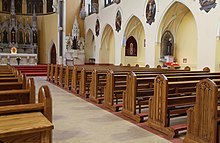
A kneeler is a cushion (also called a tuffet, hassock, genuflexorium, or genuflectorium) or a piece of furniture used for resting in a kneeling position during Christian prayer.[1]

In many churches, pews are equipped with kneelers in front of the seating bench so members of the congregation can kneel on them instead of the floor. In a few other situations, such as confessionals and areas in front of an altar, kneelers for kneeling during prayer or sacraments may also be used. Traditionally, altar rails often have built-in knee cushions to facilitate reception of Holy Communion while kneeling.
A kneeler is also a part of the prie-dieu prayer desk.
Kneelers in churches are a modern development. Kneeling was not part of the Mass in early Christianity, and has been part of the Catholic Mass since the 16th century.[2]
See also[edit]
References[edit]
- ^ "Why Do Roman Catholics Kneel at Mass?". aleteia.org. 31 March 2019. Archived from the original on 23 April 2021. Retrieved 23 April 2021.
- ^ "Why the Various Postures at Mass". www.ewtn.com. Archived from the original on 2021-04-23. Retrieved 2021-04-23.
Well, that’s interesting to know that Psilotum nudum are known as whisk ferns. Psilotum nudum is the commoner species of the two. While the P. flaccidum is a rare species and is found in the tropical islands. Both the species are usually epiphytic in habit and grow upon tree ferns. These species may also be terrestrial and grow in humus or in the crevices of the rocks.
View the detailed Guide of Psilotum nudum: Detailed Study Of Psilotum Nudum (Whisk Fern), Classification, Anatomy, Reproduction